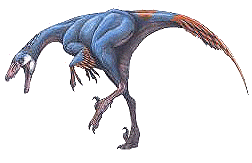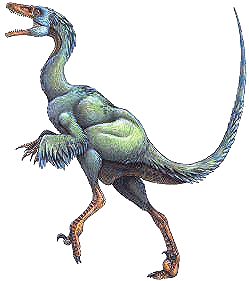|
Troodontidae |
|
The troodontids are best characterized as small, rather delicate
theropods with relatively the largest brains of any classic dinosaur,
long and slender legs, and unusual teeth that have been mistaken for
those of the ornithischian group
Pachycephalosauria. These teeth have led some researchers to
suggest that they were omnivorous. Like
ornithomimosauroids, they had large eyes. Troodontidae has proven
hard to classify, and can be linked by various characteristics with
Spinosauridae,
Dromaeosauridae,
Oviraptorosauria, and Ornithomimosauria. In the recent past, they
were often combined with the ornithomimosaurians into a taxon called
Bullatosauria, meaning "inflated reptiles" (referring to a "swollen"
bone in the braincase). Part of the difficulty is that they are still
rather poorly known; only one really complete skeleton, that
attributed to Sinornithoides, has been uncovered. In
addition, until recently there had been no good basal troodontid
remains known, hindering comparisons. With the discovery of
Sinovenator, however, Troodontidae seems to mesh with
Dromaeosauridae in Deinonychosauria, just as in the early 1980s.
For a long time, this family was known as Saurornithoididae,
because Troodon was thought to be a dubious
pachycephalosaurid. It may return to this name if recent
investigations into Troodon show that the type teeth are not "troodontid". |
 |
Sinornithoides youngi
-
110 MYA
Mongolia, China. 3.5 feet long
The first dinosaur discovered with primitive feathers. |
 |
Troodon Formosus -
67 MYA
Montana, USA; Alberta, Canada. - 6 feet long.
The "type" species. |
|
 |
Mei long - 130 MYA
Liaoning Province, China - 21 inches
long
This 2004 discovery is remarkable because its forelimbs are folded
birdlike next to its body |
|
|
Other Species |
|
|
The Troodontidae are very rare in the
fossil record. Only nine species are known. They
include: |
|
|
Saurornithoides mongoliensis (Late Cretaceous, Mongolia) |
|
|
Borogovia gracilicrus (Late Cretaceous, Mongolia) |
|
|
Sinovenator changii [sic] (Early Cretaceous, China) |
|
|
Byronosaurus jaffei (Late Cretaceous, Mongolia) |
|
|
Sinusonasus magnodens (Early Cretaceous, China) |
|
|
Mei long (Early
Cretaceous, China)
"soundly sleeping dragon" is a duck-sized
species of dinosaur first unearth by paleontologists in Liaoning,
China in 2004. Some of the unearthed fossils from the site,
preserved in three-dimensional detail, were found with their faces
nestled behind one of their forelimbs, similar to a sleeping
position ducks sometimes posture. The fossil provides a possible
behavioral link between birds
and dinosaurs. |
|
|
|
|
|
|
|
|
|
|
|
|
|
|
|
|
|
|
|
|
|
|
|
|
|
Edugraphics.Net | Feenixx Publishing |
|
|
|
|
![]()


